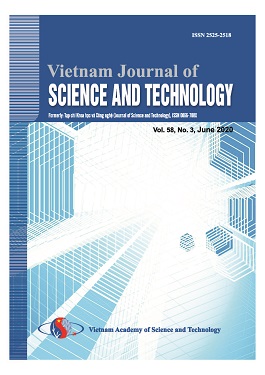Effects of pH of TEOS solution on morphology, thermal stability and mechanical properties of EVA/silica nanocomposites prepared by sol-gel method
Author affiliations
DOI:
https://doi.org/10.15625/0866-708X/51/1/9564Keywords:
nanosilica, ethylene-vinyl acetate copolymer, EVA/silica nanocomposites, sol-gel mechanism, pH influenceAbstract
Ethylene-vinyl acetate copolymer/silica nanocomposites (EVA/silica) were prepared by mixing EVA solutions and tetraethylorthosilicate (TEOS) solutions. Silica particles were formed through sol-gel mechanism with the aid of hydrochloric acid catalyst and dispersed in EVA matrix. The pH of TEOS solutions was controlled from 1 to 6. The influence of pH on formation of silica in EVA matrix, as well as morphology, thermal stability of the nanocomposites were characterized by using Fourier transform infrared spectroscopy (FTIR), thermogravimetric analysis (TGA) and field emission scanning electron microscopy (FESEM). The FTIR spectra of the nanocomposites clearly indicated the presence of silica in EVA matrix, the shifts of Si-O stretching vibration in the nanocomposites in comparison with pure silica were also observed. This can be explained by hydrogen bonding between SiOH groups of the silica and carbonyl groups of vinyl acetate units in EVA. The TGA results of the nanocomposites showed that silica could improve thermal stability of EVA. Comparing preparation conditions at pH from 1 to 4, it is clear that at the lower pH the higher content of silica was formed in EVA matrix, 3.78; 3.70; 2.50 and 2.09 wt.% respectively. The FESEM images of the nanocomposites showed that nanoscale dispersion of silica was observed obviously at pH of 4 - 6, whereas during their preparation at pH of 1 - 3, the obtained silica particles formed mainly in microscale. The pH also affected on the mechanical properties (tensile strength, elongation at break) of EVA/silica nanocomposites. At pH of 1 - 3, the silica particles formed mainly in larger size, thereby they reduced the mechanical properties of EVA. At pH of 4 - 6, the nanosilica particles had significantly improved mechanical properties of EVA, particularly at pH of 4. The improvement of shear modulus of EVA/silica was also discussed.
Downloads
Downloads
Published
How to Cite
Issue
Section
License

This work is licensed under a Creative Commons Attribution-ShareAlike 4.0 International License.
Vietnam Journal of Sciences and Technology (VJST) is an open access and peer-reviewed journal. All academic publications could be made free to read and downloaded for everyone. In addition, articles are published under term of the Creative Commons Attribution-ShareAlike 4.0 International (CC BY-SA) Licence which permits use, distribution and reproduction in any medium, provided the original work is properly cited & ShareAlike terms followed.
Copyright on any research article published in VJST is retained by the respective author(s), without restrictions. Authors grant VAST Journals System a license to publish the article and identify itself as the original publisher. Upon author(s) by giving permission to VJST either via VJST journal portal or other channel to publish their research work in VJST agrees to all the terms and conditions of https://creativecommons.org/licenses/by-sa/4.0/ License and terms & condition set by VJST.
Authors have the responsibility of to secure all necessary copyright permissions for the use of 3rd-party materials in their manuscript.







 Vietnam Journal of Science and Technology (VJST) is pleased to notice:
Vietnam Journal of Science and Technology (VJST) is pleased to notice: